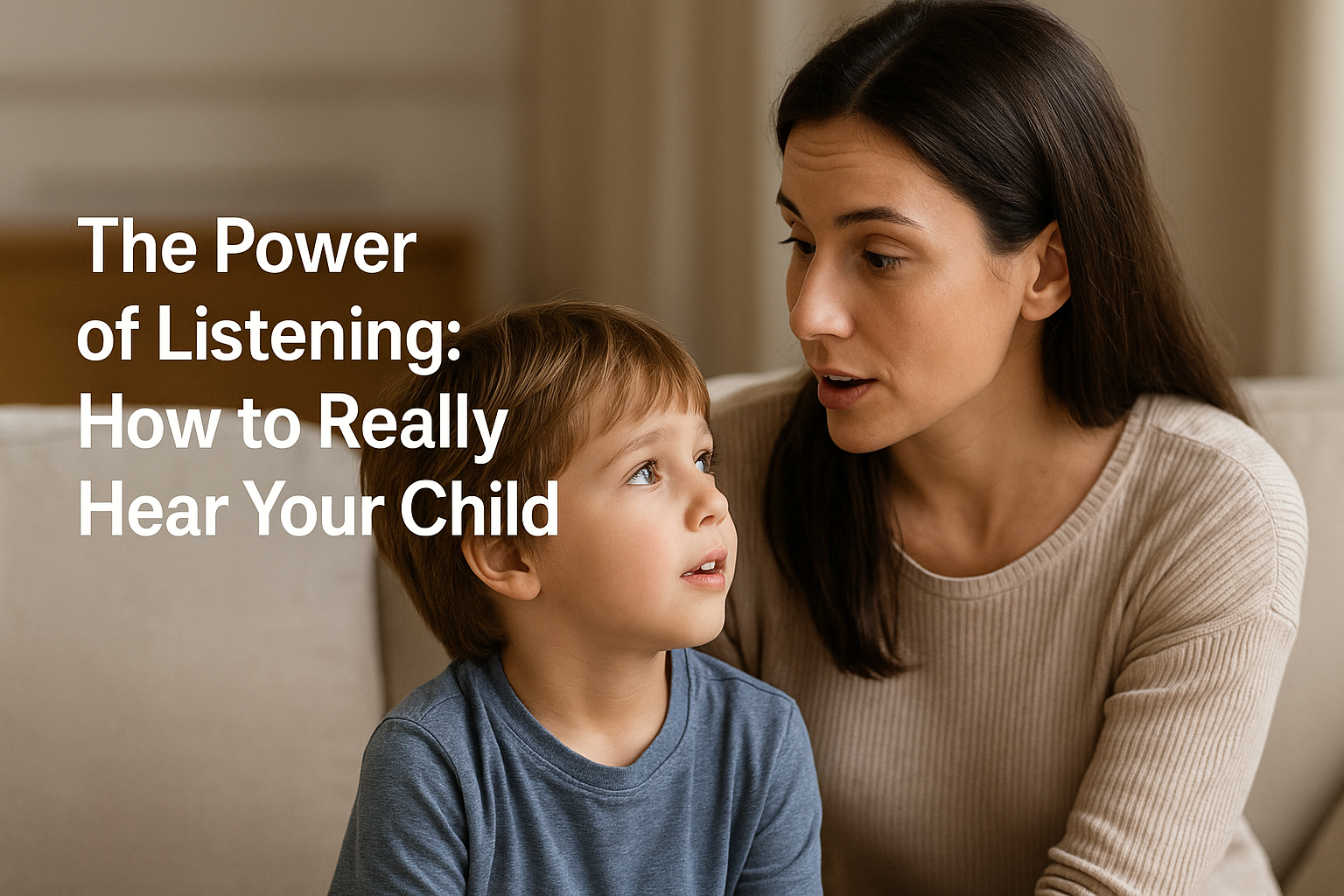Children don’t just need to be spoken to—they need to be heard. Listening is one of the most powerful parenting tools you have. It builds trust, deepens connection, and helps your child feel safe, valued, and understood.
When children feel heard, they’re more likely to:
- Open up about their thoughts and feelings
- Cooperate with instructions
- Build healthy self-esteem
- Learn to listen and empathize with others
Let’s explore how you can become a better listener for your child—and why it matters more than you might think.
Why Listening Matters More Than Talking
It’s easy to focus on teaching, correcting, or advising as a parent. But listening does something even more important: it tells your child, “You matter.”
When you truly listen, you’re saying:
- “Your voice is important.”
- “You are worth my time.”
- “I care about what you’re feeling—even if I don’t agree.”
This emotional security becomes the foundation of a lifelong bond.
1. Stop What You’re Doing (When You Can)
Children notice when your body is present but your attention is not.
Whenever possible, pause what you’re doing and turn your attention to them:
- Make eye contact
- Get down to their eye level
- Use an open, relaxed posture
You don’t need to stop everything—but when the moment is emotionally charged or important to your child, show them they have your focus.
2. Listen to Understand—Not to React
Often, we listen with the intent to correct, judge, or give advice. But real listening means being fully present without jumping in.
Instead of thinking, “What should I say next?” ask:
- “What is my child trying to tell me?”
- “What emotions are behind their words?”
- “Do they just want to be heard—or are they asking for help?”
Give space for your child to finish their thoughts without interruption.
3. Reflect Back What You Hear
This simple technique shows you’re truly engaged—and helps your child feel validated.
Examples:
- “So you felt left out at recess today?”
- “It sounds like you were really nervous before the test.”
- “You’re upset because your sister took your toy without asking.”
Reflection helps kids name their emotions, process their experiences, and feel understood.
4. Avoid Dismissing Their Feelings
Even if something seems “small” to you, it might feel huge to your child.
Avoid phrases like:
- “You’re overreacting.”
- “It’s not a big deal.”
- “Stop crying.”
Instead, try:
- “That sounds really frustrating.”
- “I can see why that upset you.”
- “Tell me more about what happened.”
Validation builds emotional safety.
5. Resist the Urge to Fix Everything
Sometimes your child doesn’t want a solution—they just want someone to listen.
Instead of offering advice right away, ask:
- “Do you want help figuring this out, or do you just want me to listen?”
- “Would you like to talk about ways to solve this, or not yet?”
This empowers your child and respects their process.
6. Pay Attention to Nonverbal Cues
Children—especially younger ones—often communicate through tone, posture, or facial expressions.
Watch for:
- Hesitation or withdrawal
- Fidgeting or physical tension
- Eye contact avoidance
- Sudden outbursts after “normal” conversations
These cues can tell you what they don’t have the words to say.
Respond with gentle curiosity:
“You seem a little off today. Want to talk about it?”
7. Create Daily Check-In Moments
Make space in your routine to connect through conversation—without distractions.
Ideas:
- At bedtime (“What was the best and hardest part of your day?”)
- In the car (no eye contact required—great for shy kids)
- While cooking or walking
- During family meals (use conversation starters)
Regular check-ins build emotional openness over time.
8. Practice Active Listening During Conflict
When your child is upset, your listening skills are most important—and most tested.
In those moments:
- Stay calm and grounded
- Let them speak without interruption
- Acknowledge their emotions before addressing behavior
Example:
“I hear that you’re angry because your brother touched your things. It’s okay to feel angry. Let’s talk about how to handle it next time without yelling.”
This teaches self-regulation by example.
9. Say Less, Listen More
The more you talk, the less your child may feel heard.
Try using silence intentionally. After your child speaks, pause before responding. That little space can invite them to go deeper or say what they’re really thinking.
Resist the urge to fill every silence with advice or reaction. Let them lead.
10. Let Listening Be the Bridge to Trust
Over time, your listening builds a safe emotional bridge. Your child will begin to think:
- “I can talk to my parent about anything.”
- “They won’t freak out or shut me down.”
- “They get me—even when I’m struggling.”
And that trust will guide your relationship through childhood, adolescence, and beyond.
Listening Is Love in Action
You don’t need all the right answers. You don’t have to be perfect. You just need to be present.
When you listen—really listen—you give your child one of the greatest gifts: the sense that their voice matters.
And from that place of safety and trust, everything else becomes possible.
